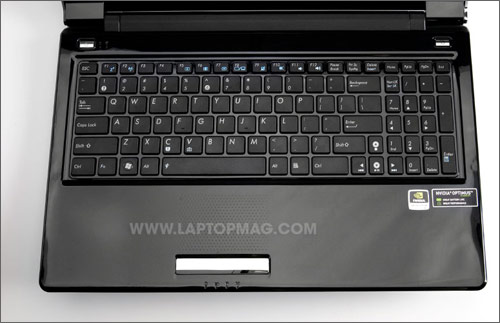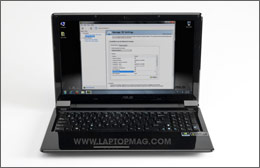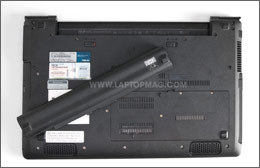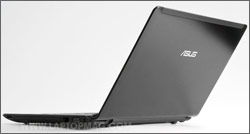Laptop Mag Verdict
Thanks to Nvidia's innovative Optimus technology, this 15-inch notebook combines good graphics power with nearly 8 hours of battery life.
Pros
- +
Seamless switchable graphics
- +
Thin and light design for 15.6-inch notebook
- +
Long battery life
- +
Can easily handle mainstream games
Cons
- -
Fingerprint smudge magnet
- -
Mushy single mouse button
- -
Could use more speaker volume
Why you can trust Laptop Mag
You don't have to flick a switch. Or press a button. Or reboot. You don't even have to lift a finger. The ASUS UL50VF-A1 ($849), a relatively lightweight 15.6-inch notebook, is the first laptop that can automatically switch between integrated graphics mode (when you need endurance) to discrete mode (when you need more power) almost instantly. The breakthrough behind this capability is Nvidia's Optimus technology, which is intelligent enough to seamlessly turn the GPU on or off based on the task at hand. We're not enamored with the design, but overall the UL50VF-A1 is a highly versatile machine.
Design
Measuring 15.1 x 10.1 x 1.0 inches and weighing 5.2 pounds, the UL50VF-A1 is roughly the same size and weight as the Dell Latitude Z600. That's a compliment; you won't find many thinner or lighter notebooks with this display size. Unfortunately, we're not fans of the glossy black chassis, a look ASUS has become somewhat addicted to. The brushed aluminum lid picked up fingerprints quickly, and smudges also marred the deck and bezel in short order. Unless you polish the system regularly, it can get downright grimy.
Heat
Overall, the UL50VF ran cool. After playing a Hulu video at full screen for 15 minutes, we measured temperatures of 93, 98, and 100 degrees Fahrenheit when we took the temperature of the touchpad, the space between the G and H keys, and the underside, respectively. All of these temperatures were slightly warmer than usual, but the notebook didn't cause discomfort when it was sitting on our lap.
Keyboard and Touchpad
The keyboard features non-glossy, island-style keys that delivered a decent amount of feedback. Some will appreciate the full-size number pad to the right of the keyboard, but the result is a slightly undersized right Shift key. We also noticed quite a bit of flex in the lower-right portion of the keyboard.
South of the keyboard is a textured touchpad area that allowed us to whip the mouse across the screen with ease. The single mouse button, however, felt mushy and offered poor feedback. (We prefer two distinct buttons.) Above the keyboard is a power button to the right and an ASUS Express Gate "instant-on" button to the left.

Click to enlarge
Display andAudio
The high-resolution 1366 x 768 display showcased bright colors during both Web surfing and watching episodes of Fight Science on Hulu. The reds in a martial arts fighter's training suit really popped. However, like other glossy displays, this one kicked back reflections during darker scenes. Viewing angles were sufficient enough for two people to take in the visuals.
The Altec Lansing stereo speakers provided enough sound to comfortably enjoy Lenny Kravitz's "Lady," but we would've liked additional volume to really rock out. We did hear good separation of high- and low-end sounds, which allowed us to clearly make out individual instruments.
Ports and Webcam
Taking a trip around the UL50VF-A1's perimeter reveals three USB ports, VGA, Ethernet, HDMI, headphone, and microphone jacks, a 3-in-1 memory card reader, an 8X DVD drive, and a Kensington lock slot. The connection ports are all built into the left and right sides of the machine for easy access.
ASUS includes a 0.3-megapixel webcam embedded above the display, which we used to chat with friends in Meebo. Buddies reported very murky images. The video feed, however, didn't suffer from any lag when we moved about quickly. ASUS' facial recognition software allowed us to log into the system using our mugs, but we discovered that it works best in well-lit areas.

Click to enlarge

Click to enlarge
CPU and Hard Drive Performance

Click to enlargeA 1.3-GHz Intel Core 2 Duo SU7300 CPU, 4GB of RAM (non-expandable), and 500GB hard drive spinning at 5,400-rpm powered the UL50VF-A1 to a respectable 3,599 PCMark Vantage score (a measure of Windows system performance.) That score is just a hair behind the 3,632 mainstream category average. The $899 Toshiba Satellite E205 (a 14-inch notebook packing a more powerful Intel Core i5-M430 CPU) turned in a 5,396 PCMark Vantage score, while the $799 Sony VAIO Y Series (a 13-inch ultraportable with the same 1.3-GHz Core 2 Duo SU7300 CPU as the UL50VF-A1 but no Nvidia graphics) was nearly 700 points lower than the ASUS.
The hard drive booted the 64-bit Windows 7 Ultimate operating system in 58 seconds, which was on a par with the 60-second mainstream average. The hard drive was also quite swift; it transferred a 4.97GB folder of mixed media at a rate of 24.0 MBps, which was faster than the 20.5 MBps category average.
Nvidia Optimus Technology and GPU Performance
While switchable graphics in a notebook is nothing new, what's innovative is the way that the UL50VF-A1 switches between its integrated (Intel GMA 4500MHD) and discrete (Nvidia GeForce G210M with 512MB of dedicated video memory) graphics. Previously, when graphics were rendered by either the integrated or discrete GPU, they had to pass through a multiplexer on the way to the display; switching between the two GPUs would cause the screen to flicker or require a system restart or log out. Optimus works by having intensive video information (such as games or Flash videos) rendered by the discrete GPU, which then swiftly copies the data to the system memory, where the Intel GPU directly drives the display (no multiplexers needed).
What this means is that the change between integrated and discrete graphics is practically instantaneous and invisible; when we installed and fired up Dungeon Fighter Online or watched 30 Rock on Hulu, there was nary a flicker of the screen as the UL50VF-A1 activated the Nvidia GPU.
Even better, Optimus knows precisely when to switch between the two graphics subsystems. It's remarkably effective in its simplicity; users will no longer accidentally leave their notebooks in discrete graphics mode, sapping precious battery life.
Still, Nvidia allows users to customize their Optimus experience. The Nvidia Control Panel lets users select which GPU should run when specific applications are opened--or even specific actions within an application (say, playing a 720p Flash video in Firefox). While most of these are preset by Nvidia (and updated automatically), it's nice to have this level of granular detail. When we right-clicked on the QuickTime and vReveal desktop shortcuts, we were able to set them to run in integrated or discrete graphics modes.
During a World of Warcraft session, the Intel GPU managed to push polygons at a lowly rate of 23 frames per second at 1024 x 768-pixel resolution, which dripped to an unplayable 6 frames per second at 1366 x 768-pixel resolution. However, the discrete Nvidia GeForce G210M GPU saw the game move along at those respective resolutions at a silky smooth 60 and 31 fps. Unlike Intel's integrated solution, Nvidia's chipset was able to handle the graphically demanding Far Cry 2; the title ran at a decent 22 frames per second at 1024 x 768, but that number dropped to 14 frames per second when we played at native resolution. In short, you'll be able to play all but the most demanding 3D titles.
Nvidia's CUDA technology, which leverages the GPU to speed up processing time, allowed us to transcode a 5 minute and 5 second video clip (using vReveal) in 2:43. That showing is 1:03 faster than other notebooks we've tested with discrete grahics. However, we saw an even faster time when we used Oxelon Media Converter (which takes advantage of a CPU's multiple cores). This time it took only 1 minute and 24 seconds, which is good but sill slower than the 52-second category average.
Wi-Fi and Battery Life

Click to enlargeThe UL50VF-A1's Wi-Fi card transferred data at a brisk rate of 46.4 Mbps when the notebook was positioned 15 feet away from our wireless access point. That number dropped to a still strong 28.3 Mbps from 50 feet.
Because the UL50VF-A1 uses an ultra-low-voltage processor and because the Nvidia GeForce G210M completely shuts down when not in use, the notebook delivered excellent battery life. It lasted 7 hours and 39 minutes on our LAPTOP Battery Test (continuous Web surfing over Wi-Fi) when running strictly on integrated graphics, and 7:50 when running in switchable mode. Both times more than doubled the 3:31 mainstream endurance average.
Green Testing

Click to enlargeIt took the UL50VF-A1 2 hours and 2 seconds to charge its 8-cell battery to 80 percent capacity; it took 3 hours and 15 minutes, total, to reach 100 percent capacity. The system had an incredibly low 15.7 LAPTOP Battery Efficiency Rating, which was far better than the 45.5 mainstream notebook average.
Configurations
The UL50VF-A1 isn't available in any other configurations.
Software and Warranty
The UL50VF-A1 comes with several ASUS-branded programs, including Express Gate, WebStorage, LifeFrame, and SmartLogon. Also pre-installed are a 60-day trial of Microsoft Office Home and Student 2007 Edition, Nvidia Control Panel, and Windows DVD Maker. ASUS covers the system with a two-year warranty, which is generous for a consumer notebook; most only come with one year of service. To see how ASUS fared in our last Tech Support Showdown, click here.
Verdict
Thanks to Nvidia's smart Optimus technology, the $849 UL50VF-A1 offers both long battery life and graphics muscle. Best of all, this notebook is smart enough switch between integrated and discrete graphics mode based on what you're doing. We wish ASUS wrapped this technology in a less glossy chassis, but overall the UL50VF-A1 is a strong 15.6-inch notebook.
[flq:76a775de4b68440589f92fc58a18e22e]
ASUS UL50VF Specs
| Brand | ASUS |
| CPU | 1.3-GHz Intel Core 2 Duo SU7300 |
| Card Slots | 3-1 card reader |
| Company Website | www.usa.asus.com |
| Display Size | 15.6 |
| Graphics Card | Intel GMA 4500MHD (Shared)/Nvidia GeForce G210M (512MB) |
| Hard Drive Size | 500GB |
| Hard Drive Speed | 5,400rpm |
| Hard Drive Type | SATA Hard Drive |
| Native Resolution | 1366x768 |
| Operating System | MS Windows 7 Ultimate (64-bit) |
| Optical Drive | DVD SuperMultiDrive |
| Optical Drive Speed | 8X |
| Ports (excluding USB) | Kensington Lock, Headphone, HDMI, Ethernet, VGA, Microphone |
| RAM | 4GB |
| RAM Upgradable to | 4GB |
| Size | 15.1 x 10.1 x 1.0 inches |
| USB Ports | 3 |
| Video Memory | 512MB |
| Warranty/Support | Two-years/24/7 toll-free phone |
| Weight | 5.2 pounds |
| Wi-Fi | 802.11n |
